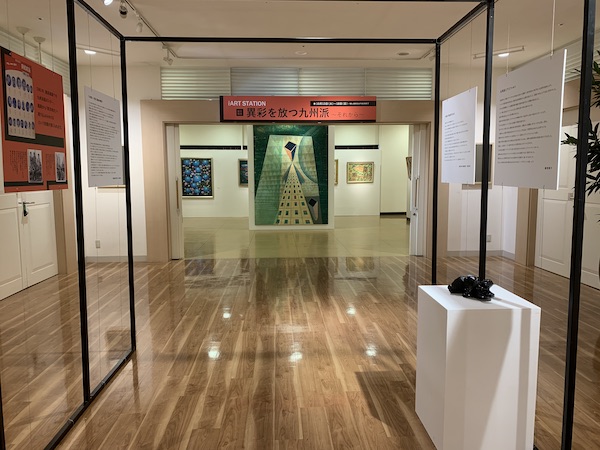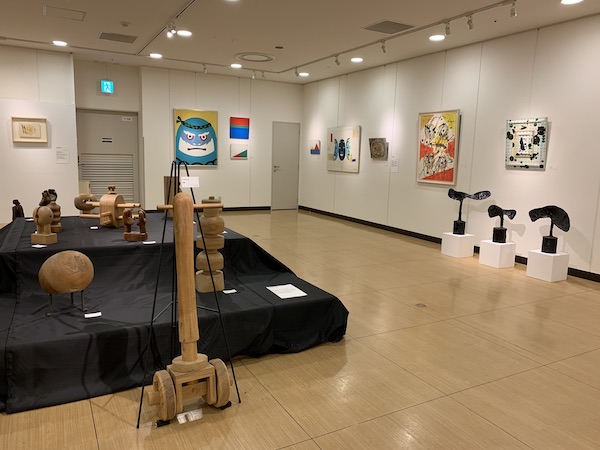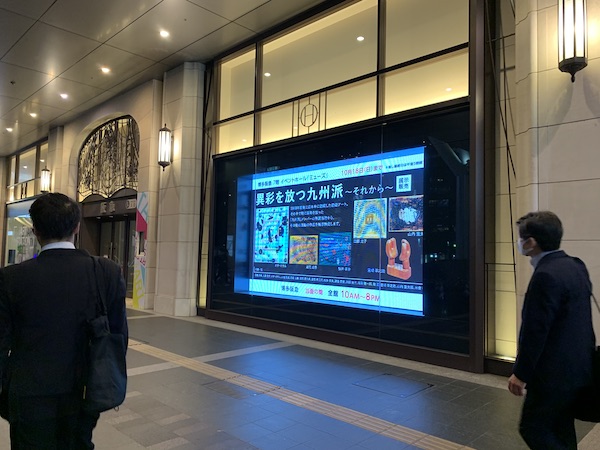九州派 | Gallery MORYTA | ギャラリーモリタ (original) (raw)
Instagrum → Kyushu-Ha Project
(戦後日本で派生しためぼしいグループの中でも)
「九州派」ほど、深い地層から熱いマグマが噴出するようなエネルギーを感じさせるグループはなかった。
<九州派顛末記/針生一郎>
<具体>と<九州派>については、アンフォルメル旋風から読売アンデパンダンの末期にいたる美術運動のなかで、この地方の美術家集団が美術におけるもっとも尖鋭な部分を担ったことは、近代美術史の上で今まで例をみなかった。
<百花斉放・六十年代初期 刀根康尚>
「組織論、運動論を模索し、表現を生活世界の内側からとらえ、表現者の思想と美術家の自立を問題とした数少ない集団である」<「美術手帖」、1971年10月号>
無頼と非インテリを偽装する九州派は、実は大変な勉強家であったのだ。
現代美術、騒乱の社会、実存主義…。戦争の抑圧から解放された芸術、政治、思想といった 多様な流れがクロスする時代の交差点から九州派は生まれた。<駆け抜けた前衛 4 西日本新聞より抜粋>
九州派は最初、抽象表現主義のアンフォルメル、アクション・ペインティングといった欧米の現代美術を借り衣装にした。しかし、単なる模倣だけでなく、独自な自己表現を、そういった素材面から追求索していたことがわかる。
さらに「芸術はゴミだ」とパロディー化し、日常の道具、生活周辺の素材を使うことで、大衆には手の届かない高尚で高踏的と思われていた 芸術を、生活者レベルに引きずり下ろす「生活者の思想」の一つの具現化でもあった。<駆け抜けた前衛 5 西日本新聞より抜粋>
博多阪急 2020年9月 異彩を放つ九州派〜それから〜 VR映像にてご覧いただけます。→VR view



われわれは、いま、美術運動のスタートに立つたと言って良いであろう。
われわれは、われわれの美術運動に 『九州派』という呼称をつけたが、それは、われわれの制作の場を、単に地域的に説明したものに過ぎない。
われわれの、もつとも基本的な態度は、あらゆる既成の観念を排して、最大限に、美術の 可能性を探究することである。現代の科学、社会から、民族性、個の問題まで、方法論的 にも、レアリズム、アブストラクト、アン・フォルメールなど、われわれが、美術を通じて対決しなければならない問題はわれわれの周囲に山積している。
われわれ九州派が志向するものは、これらの問題と取り組み、解決をはかりながら、真に ユニークな、われわれの美術を創造することである。
(九州派 機関誌#1)
1957年、九州福岡の地に突如出現した
前衛美術集団「九州派」。
反芸術、反中央、反公募展を掲げ
アスファルトやコールタールを
絵具代わりに使い
ハプニングと呼ばれた表現活動など
斬新で強力な訴求力をもった
ムーブメントを展開していた。
2020年、
当時の若き九州派のアーティストの偉業を
再発見、再認識し、アートの力で
閉塞した現代社会を打破すべく
動き始めます。
また、現代の情報ツールを使い、
九州派と在籍メンバーの
その後のアート活動を
国内外に向けて発信していきます。
戦後の福岡で産声を上げた、奇跡の前衛美術集団(九州派大全より)
▪️ 九州派
1950年代後半から60年代初め(昭和30年代)は、国内外において芸術の変革が叫ばれはじめ、 多種多様な美術が登場し始めた時期にあたります。日本においては、この頃東京だけでなく各地方都市でも様々な前衛美術グループが結成されました。既存の公募団体によって作り上げられた美術システムに不満争抱いた若い美術家たちがグループを結成し、無審査の公募展「読売アンデパンダン展」や屋外など作品展示には向かないような場所や舞台として、「絵画」「彫刻」 の枠には収まりきれないエネルギーあふれる実験的な作品を発表し始めました。東京の「ネオ・ダダ」 、 関西の「具体美術協会」がその代表的なものですが、中でもとりわけ異彩を放っているのが福岡市で結成された「九州派」です。
桜井孝身、オチオサムらを中心に結成された「九州派」の特徴は、生活者の視点からの美術表現や人々の生活に根ざした活動姿勢にあると言えます。それは日常の現実の中に美術や引き下ろし、また逆に、 日常の卑俗さなどを一つの美術表現に高めようとする行為、と言い換えられるでしょう。これは、九州派メンバーのほとんどが専門的な美術教育を受けておらず、「画家」であると問時に「生活者(労働者)」 であるという意識を強く持っていたこと、当時福岡県内では三井三池争議に代表される労働組合運動が盛り上がっており、思想的に共鳴する者が九州派内に含まれていたことなどが背景となっていると思われます。
九州派の作家たちは廃材やごみを作品素材として用いましたが、最も特徴的なものがアスフアルトです。印刷会社勤務のオチオサムが印刷工程で見出し、九州派のほぼ全員が利用しました。都市化の進み始めた福岡市内で入手しやすかったアスフアルトは、安価で、しかも独特の光沢争もち乾燥も早かったためです。また光沢のある黒という色が、日本の近代化を支えた三池の石炭と労働者のエネルギーを連想させたため、この素材は九州派のトレードマークとなりました。 結成当初は、東京での頻繁な展覧会活動によるその存在のアピール、そしてアンデパンダン展の組織などによる地元美術界の再編を試みました。しかし「前衛」に対する意識の違いから 1959年末に大分裂。桜井により再建されるも、彼らが思想的根拠争置いていた三井三池労働争議が 1960年に組合側の敗北に終わるという時代背景の変化とともに、九州派自身も活動のエネルギーや失い、1968年のグループ展参加を最後にその活動に幕を下ろしました。
作品の保存よりもまずその効果やアピール度を重要視した作品が多く、作品の形やともなわない活動形態も数多くあったため、作品として現存するものは極めて少なく、九州派は長い間伝説のベールに包まれたままでした。1988年、福岡市美術館における「九州派援一反芸術プロジェクト」 の開催で、その全容が明らかとなりました。2015年には、同館の編集による「九州派大全」 (福岡市文化芸術振興財団発行)が刊行され、九州派への注目が高まっています。
【English】
Of all the groups that emerged in Japan after World War II, none has evoked the energy of a hot magma erupting from a deep stratum of earth like Kyushu-Ha.<Ichiro Hariu>
Gutai and Kyushu-Ha art movements from the Unformel to the end of the Yomiuri Independents were unprecedented in the history of modern art, with local artists playing the sharpest edge in the art world.<Yasunao Tone>
Kyushu-Ha is one of the few groups that have sought a theory of organization and a theory of movement, that have taken expression from within the living world, and that have made the idea of expression and the independence of the artist an issue.<BIJUTSU TECHO October 1971>
The members of Kyushu-Ha, who disguise themselves as incorrigible and unintellectuals, are in fact very studious people. Kyushu-Ha was born at the crossroads of diverse streams of art, politics, and thought, including contemporary art, a society in turmoil, and existentialism, all freed from the oppression of war.<NISHINIPPON SHINBUN>
At first, Kyushu-Ha borrowed Western contemporary art, such as Abstract Expressionist informel and action painting, as his costume. However, it is clear that Kyushu-Ha was not merely imitating, but was also pursuing its own unique self-expression in terms of such materials. Furthermore, by parodying the idea that “art is trash” and using everyday tools and materials from the periphery of life, it was an embodiment of the “sei-katsu-sha idea” that brought art, which had been thought of as lofty and high-minded and out of reach of the masses, down to the level of the sei-katsu-sha.<NISHINIPPON SHINBUN>
About Kyushu-Ha
From the late 1950s and early 60s, changes in the art world began to take place both nationally and internationally and a wide variety of art appeared. Around this time various Avant-garde groups were founded in Japan; not only in Tokyo, but various other cities as well.
Young artists dissatisfied with the traditional art system formed a new group and started releasing energetic, experimental works that couldn’t fit into such categories as “painting“ or “sculpting“.
The “Neo Dada“ in Tokyo and the “Gutai“ in Kansai are representative of that time, but above all the “Kyushu-Ha” formed in Fukuoka City is one of the most distinctive groups of that time. “Kyushu-Ha” was formed by Takami Sakuraiand Ochi Osamu and it can be said that their characteristic is the approach of looking at artistic expression and everyday activities from the perspective of an ordinary person. In other words, art is brought down to daily reality, and conversly, everyday coarseness is raised to the level of artistic expression.
Most members of Kyushu-Ha did not receive a special art education, which is why they were strongly aware of being „ordinary civilians (workers)“, when among „painters“. At the same time the labor union movement represented by Mitsui Miike was on the rise in Fukuoka Prefecture and it seems that their ideology resonated with members of Kyushu-Ha.
The Kyushu-Ha artists used scrap wood and waste, but their most characteristic material is Asphalt. Ochi Osamu discovered this method while working at a publishing company and almost all members of Kyushu-Ha used it. Asphalt was easy to obtain in Fukuoka city, where urbanisation began to advance because it was cheap. Moreover, it had a unique luster and dried quickly. The shiny black colour was associated with Miike’s coal and the energy of workers, who supported the modernisation of Japan, which is why this material became a Kyushu-Ha trademark.
In the beginning of their formation Kyushu-Ha tried to call attention to their existence by frequently holding exhibitions in Tokyo and by holding independent exhibitions to reorganise the local art scene. However, due to the difference in awareness of “Avant-garde” the group experienced a major division at the end of 1959.
Eventhough Sakurai tried to rebuild Kyushu-Ha, due to the ideological background being established on Mitsui Miike’s labor dispute, with the defeat of the union in 1960, Kyushu-Ha itself also lost its energy, and lastly ended their activities by participating in a group exhibition in 1968.
Kyushu-Ha placed more emphasis on the effect and degree of appeal of their work rather than the preservation; there are many works that take the form of actions rather than a solid shape, which is why there are very few still existing art works. Due to this, Kyushu-Ha had been conceiled by a legendary veil for a long time.
In 1988, the “Kyushu-Ha One Anti-Art Project” was held at the Fukuoka Art Museum, and the full story was made public. The “Kyushu-Ha Taizen“ edited by the same museum was published in 2015 and Kyushu-Ha started gathering attention worldwide
【Chinese】
1950年代後半到60年代初期(日本昭和30年),世界各地藝術革命風起雲湧,各種藝術流派相繼登場。
不僅在日本東京也在各個城市也出現了形式多樣的前衛藝術團體。
對社會上傳統的舊有團體的藝術體係抱有不滿的年輕藝術家們組成了一個團體,開始舉辦不受審查的大眾性展會“讀賣Independent展”,利用戶外等本不適合舉辦作品展的場所和舞台,發表了不少未被視為”繪畫”、”彫塑”的正統藝術形式的、充滿衝擊力試驗性作品。東京的“新達達主義組織”和關西的”具体美術協会”成為其代表,在福岡市形成的“九州派”更是異彩綻放。
以櫻井孝身,Ochi Osamu等為中心組成的“九州派”,其創作特點是從庶民階層的視野發韌的美術表現,根植於一般普通人的生活觀念,把藝術擋次拉低於日常生活的現實中,把日常現實中的低俗行為提升到一種藝術表現形式的行為。
換言之,這是因為九州派成員幾乎都沒有接受過正統的美術教育,強烈持有既是“畫家”,同時又是“勞工(勞動者)”的意識。其背景是當時在福岡的三井三池抗爭事件中,工會組織的運動,對九州派成員在思想上產生了強烈共鳴。
九州派的作家們使用廢料和垃圾作為創作素材,其中最具特色的是使用瀝青*1。在印刷公司工作的Ochi Osamu在印刷工作中發現了瀝青的表現作用,九州派的幾乎所有人都開始使用。因為正處於城市化進程中的福岡市容易找到瀝青,因其價格低廉。並且,瀝青具有獨特的光澤和快速乾燥的特點。閃亮的黑色讓人聯想起支撐了日本近代化發展的三池煤礦的煤炭和礦工擁有的能量。使用這個素材成為了九州派的標誌。九州派成立之初,通過在東京頻繁舉辦展覽會來彰顯自已存在的魅力,並試圖通過獨立藝術家協會策展組織活動來重新組建當時的美術界。
因“前衛”意識的差異,1959年末內部發生了大分裂。後雖由櫻井重建,但作為他們思想依託的三井三池抗爭事件,在1960年以工會方面的失敗而告終,時代背景發生了變化。同時,九州派自己活動的能量也逐漸式微,1968年舉辦集團展會後,九州派的活動降下帷幕。
九州派大多数的作品比起保存更重視效果,九州派有許多作品以活動表現,所以,現存的作品極少。九州派長時間一直被蒙上了一層面紗。 1988年福岡市美術館舉辦了“九州派援一反藝術計劃”,才清楚展顯了它的全貌。
2015年,福岡市美術館編輯出版了“九州派大全”(福岡市文化藝術推進基金會),對九州派的關注度越來越高。
【最近の活動について】
桜井孝身の哲学から「奇跡の前衛美術集団 九州派」を読み解く作品集制作プロジェクト website
展覧会開催:異彩を放つ九州派〜それから〜 博多阪急 2020.10.13-10.18 website
「THE ART STATION@博多阪急7F:異彩を放つ九州派〜それから〜」について website
福岡のニュース 博多阪急『HAKATA ART STATION』の注目企画がスタート『異彩を放つ九州派~それから~2021』 website
森の空想ブログ 「異彩を放つ九州派―それから」展①・会場風景/アートが占う九州の未来:博多阪急にて「九州派」と現代美術作家の競演[風・アート・旅の空<3>] website
西日本新聞 ARTNE : アートが占う九州の未来 博多阪急で「九州派」展と「Kyushu New Art」 website
展覧会開催:異彩を放つ九州派 ―そして なかお画廊 2020.11.8-11.30 website
令和に蘇る「九州派」tolk-jamhart-japlog website
講演会開催:講演会「反芸術と九州派について」林田龍太熊本県立美術館学芸員 2020.11.7 蔦屋書店熊本三年坂 article 熊日新聞 website
「九州派」を知っていますか? MOMO BLOG website
展覧会開催:「九州派 / 東京地方 突如来演 2020」展 画廊香月 2020.12.7 – 26 website
美術手帖掲載: 九州派 / 東京地方 突如来演 2020 website
美術手帖掲載: 東京中心のアート界の構造に挑む 山本浩貴評「九州派/東京地方 突如来演 2020」 website
月刊ギャラリー 美の散策#1 市原尚士 article
【Article Japanese】
度肝抜いた前衛芸術「九州派」悔いなき熱狂の日々 西日本新聞 1981.8.18 article
百花斉放・60 年代初期 美術手帖 1971.10 からの抜粋 刀根康尚 ARTICLE
西日本新聞 文化欄 前衛たちの軌跡 九州派から四半世紀 1988年 #桜井孝身・#石橋泰幸・#宮崎準之助・#小幡英資&大黒愛子・
【Text Japanese】
九州派 text
孝身のパフォーマンス 阿部成人(元フクニチ新聞文化部記者)上・中・下
九州派を追いかけて text
九州派 作家のことば text
九州派の紹介 桜井孝身 text
九州派は前進する 桜井孝身 text
世界画壇をとる- 回路からの報告書 風濤 no.1 (風濤書房/1976年) text
九州芸術を世界に 桜井孝身 text
九州派私記 山内重太郎 海図出版 #1・#2・#3・#4・#5
九州派機関誌三号 山内重太郎 text
九州派3人展 トキワ画廊 1958 パンフレットの文章 山内重太郎 text
「サビツイタ裸女」誕生 山内重太郎 九州派機関誌 text
アンフォルメル雑感 山内重太郎 九州派機関誌 text
亡霊に照明を当ててみると 田中幸人 元毎日新聞記者・元埼玉県立近代美術館長 text
九州派機関誌より
機関誌1号
九州派 text
未知のエネルギーの処方箋 text
「英雄たちの大集会レポート」#I・#II・#III・#IV・#V・#VI・#VII・#VIII・#IX・#X
「英雄たちの大集会」=ニューヨーク=命令する芸術への九州派会合通知提案 #1・#2
「命令する芸術 英雄たちの大集会― ニューヨークについて」#1・#2・#3・#4・#5・#6・#7・#8・#9・#10・#11
「結論として」Text
1960年前後、激動する時代を背景にアンフォルメル絵画とオブジェを武器として「芸術」と「東京」に総攻撃をかけた驚異の前衛美術集団 九州派展 GROUP KYUSHU HA 反芸術プロジェクトより 桜井孝身text
生きてることが全て芸術だ 桜井孝身Text
【Website Japanese】
美術手帖 ART WIKI 九州派 website
現代美術史日本篇 Contemporary Art History: Japan website
art scape website
東方文化支援財団 代表 中野善壽氏の視察・講演 website
美術手帖 ART WIKI website
ARTNE 再評価をされる九州派・福岡市美術館コレクション展 website
九州派の「その後」知る作品展 福岡市のギャラリーモリタ website
福岡市美術館 九州派展 website
Living Well Is the Best Revenge 九州派」展 2016年 01月 17日 website
ART IT 九州派展 @ 福岡市美術館 website
九州派展 戦後の福岡で産声を上げた、奇跡の前衛集団。その歴史を再訪する website
九州派展──戦後の福岡で産声を上げた、奇跡の前衛集団。その歴史を再訪する FUKUZUMI REN website
Internet Museum 九州派展 website
Art- Exhibition,Tokyo website
九州派……時代を駆け抜け、なお美術の第一線 田部光子さんトーク website
東京文化財研究所 九州派展開催 website
博司のナンコレ美術体験 おすすめ展覧会カタログベスト10 website
京都大学学術情報リポジトリ 九州派における交流活動考察 -交流を通した連帯、グループ意識の共感をめぐって- 鄭, 賢娥 website
東京国立近代美術館・京都国立近代美術館 痕跡ー戦後美術における身体と思考
久我記念美術館を育てた山内・尾花作品も website
SEAヒストリー研究会~日本におけるSEAを読み解く 第2回実施報告 website
【Text English】
Kyushu-Ha Journal
#1 Kyushu-Ha text
Kyusyu-Ha 「Blue House」 text
Kyushu-Ha Personal Records Jutaro Yamauchi text
Kyushu-ha Memorandum Jutaro Yamauchi text
Words of Kyushu-Ha text
Heroes of Kyushu-Ha #1・#2・#3・#4・#5・#6・#7
A Personal History of Kyushu-Ha Jutaro Yamauchi #1・#2・#3・#4・#5
A fighting mikoshi that ran through the age Tatsuo Ikeda text
About “Kyushu-Ha Yukito Tanaka text
“Kyushu-Ha Exhibition” Hiroshi Minamishima (Former Director, Contemporary Art Museum, Kumamoto ) text
Introduction to Kyushu-Ha Takami Sakurai text
Taking the World Art World – A Report from the Circuit Takami Sakurai text
【Article English】
Nikkei news paper 3rd May 2020 What is Kyushu-Ha?(1)article article
Nikkei news paper 10th May 2020 What is Kyushu-Ha?(2)article article
Nishinippon Shinbun Trajectory of the Avant-gardeSeptember 26 – October 8, 1988 #Takami Sakurai・#Yasuyuki Ishibashi・#Junnosuke Miyazaki・
The Fighting Mikoshi that Ran Through Tatsuo Ikeda text
【Website English】
The movements that shaped Japanese post-war art CHRISTIES website
WIKIPEDIA ENGLISH website
ASIA ART ARCHIVE website
【Article Chinese】
Nikkei news paper 3rd May 2020 What is Kyushu-Ha?(1)article
Nikkei news paper 10th May 2020 What is Kyushu-Ha?(2)article
Gallery MORYTA exhibition 九州派 2019 website
Gallery MORYTA exhibition 九州派 2018 website